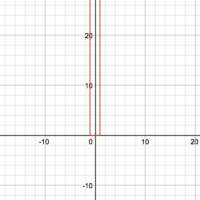You are using an out of date browser. It may not display this or other websites correctly.
You should upgrade or use an alternative browser.
You should upgrade or use an alternative browser.
Help please
- Thread starter k1x
- Start date
Dr.Peterson
Elite Member
- Joined
- Nov 12, 2017
- Messages
- 16,092
What is that supposed to be the graph of? There is no variable in the question.
And how does it help with the question???
And how does it help with the question???
HallsofIvy
Elite Member
- Joined
- Jan 27, 2012
- Messages
- 7,763
I have no idea what you are trying to say. The quantity asked about in the first post is a single number, not a function. What is your graph of? What is giving this parabola?
(Two great minds with a single thought!)
(Two great minds with a single thought!)
Dr.Peterson
Elite Member
- Joined
- Nov 12, 2017
- Messages
- 16,092
Graphs say nothing about divisibility.
Dr.Peterson
Elite Member
- Joined
- Nov 12, 2017
- Messages
- 16,092
Well to be honest I do not have a clue on how to solve this problem. I was given it in a math olympiad but it was too hard for me.Where did you get that sum? It doesn't seem quite big enough to me, since 2020^2020 alone is about 6.45*10^6676.
(By the way, I don't have an answer to the question yet, myself.)
@k1x, please tell us what you have learned about divisibility that might be relevant to the problem.
Dr.Peterson
Elite Member
- Joined
- Nov 12, 2017
- Messages
- 16,092
Given that it is an Olympiad problem, I tried using a relatively simple fact from number theory, Fermat's Little Theorem, which such contests use a lot. That turns out to work nicely.
So that you can benefit from the problem, I will give you only that hint for now. If you don't know the theorem, look it up; then think about what it means modulo 11. Then look at what that tells you about each term in the sum.
Let me know what you find. It will require a little more than what I have explicitly told you, so you will have to think!
So that you can benefit from the problem, I will give you only that hint for now. If you don't know the theorem, look it up; then think about what it means modulo 11. Then look at what that tells you about each term in the sum.
Let me know what you find. It will require a little more than what I have explicitly told you, so you will have to think!
Steven G
Elite Member
- Joined
- Dec 30, 2014
- Messages
- 14,383
I biffed big time on this one. I think that I switched my powers around.
Let us try again.
What you have is x^2020 as a constant since you are summing up over n. I suspect that n=x but you did not say this nor did you need two variables.[MATH]\sum _{n=1}^{2020} x^{2020}[/MATH]
See what you can do from there.
Is that right, Dr. Peterson?
But how will this help? You just rewrote the given sum in a different format
I think I understood how to solve the problem. Lets take 2020 as 10*202. Then every number except the multiples of 11 is congruent to 1^202(mod11).
Because we have 2020 numbers added up in total there's 183 multiples of 11 so we'll not need them since they have no remainder when divided by 11.
2020-183 = 1837. . Since 1837 is divisible by 11 then the whole number is divisible by 11.
. Since 1837 is divisible by 11 then the whole number is divisible by 11.
Because we have 2020 numbers added up in total there's 183 multiples of 11 so we'll not need them since they have no remainder when divided by 11.
2020-183 = 1837.
Dr.Peterson
Elite Member
- Joined
- Nov 12, 2017
- Messages
- 16,092
Exactly. Good work!
For those who might be reading without having looked it up, FLT tells us that any number not congruent to 0, raised to the 10th power, is congruent to 1 (mod 11). There will be 183 0's and 1837 1's in the sum.
For those who might be reading without having looked it up, FLT tells us that any number not congruent to 0, raised to the 10th power, is congruent to 1 (mod 11). There will be 183 0's and 1837 1's in the sum.

